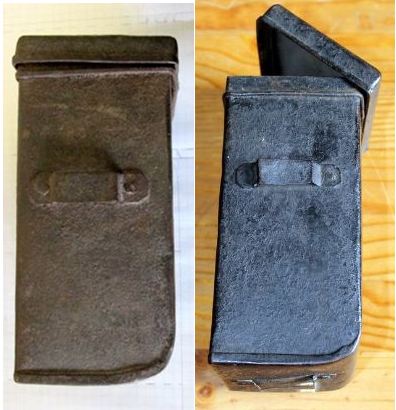Thursday, April 18, 2013 10:05:22 AM MDT
The first two I made were using the Sketchbook 76 or the Brigade of American Revolution pattern. Then I learned the body should be made in one piece and those first couple were in two parts and they were too big to match the Board of War specifications.
Here are the 2 originals.
Specifications from the Board of War in the spring of 1778. They are to be six inches and a half deep, or long. Three inches and three quarters of an inch broad, and two inches and seven eights of an inch thick. Will contain thirty-six cartridges with one ounce balls.
However they were not just used to carry cartridges…
Valley Forge orderly book of General George Weedon of Continental Army…
By George Weedon, American Philosophical Society
Pg 98
Lt. Rains of the 15th Virga. Charg’d with sending a soldier (William Bluford) to bring water in a tin cartouch box, found not guilty by unanimous opinion of the court.
and
Charles Carroll to Washington.
“Lancaster, 27th September, 1777…
Dear Sir;
I have had conversation with Mr. Peters, secretary to our board, who informs me that in the month of June last 1000 tin cartridge boxes were sent to the Army and delivered to a Captain French. Mr. Peters moreover informs me that to his certain knowledge several of these cartridge boxes were converted by the soldiers into cantines, and by some officers into shaving boxes. Commissary Flowers also acquainted me that there are now at Carlisle upwards of 2000 tin cartridge boxes; if these are wanted in the Army they may be immediately sent for …” Kate Mason Rowland, The Life of Charles Carroll of Carrolton 1737 – 1832 with his Correspondance and Public Papers, vol 1 (New York and Londn: G.P Putman’s Sons, 1898), 217-218.
They were made of tinned iron and sheet iron.
I have been making them with both. If made with sheet iron they need to be japanned to prevent them from rusting. Japanning is a coating of asphaltum and spar varnish. I am making them truly “Japanned”. Otherwise I would just be “painting”.
Japanned tinware is not just painted black but it is a glossy surface coating that is heated to cure. You can japan tin, leather, wood, papier mache and japanned felt was even used for roofing. The coloring can be blue, yellow, red, brown, etc but the most common is black. The black coloring can come from charred vegetable matter, lamp black, or asphaltum. Asphaltum is also called Bitumen or Judean Pitch.
Asphaltum was used by Egyptians in embalming, which they called numia mineralis.
In America, asphaltum was discovered in Utah where Samuel Gilson marketed asphaltum as Gilsonite
Instructions for Japanning can be found in John Stalker and George Parsons A Treatise of Japanning and Varnishing 1688 and Robert Dossies The Handmaid to the Arts: In Two Volumes 1764.
The Handmaid to the Arts: In Two Volumes 1764 talks about the use of a primer before japanning. This priming does make a difference when it comes to flaking of the material.
There is a vendor selling Black Japanning Asphaltum paint that says do not stove under any circumstances which makes me think it nothing more than paint and not an Historic product.
The heating of Japan lacquer causes it to harden. Even leather is heated when making patent leather as descibed by Arnold James Cooley, John Cargill Brough in Cooley’s cyclopaedia of practical receipts, processes: and collateral Information 1864 and The Artist’s Assistant: Or School of Science; Forming a Practical Introduction to Polite Arts 1801 says “every degree that can be applied… tends to give it a more firm and strong texture”
English Mechanics and the World of Science, Volume 34 from 1882 says ten to twelve hours at 212 degrees.
The Japanned version is available here:


Do you have a 1770’s British army one please. We know they were frequently issued 60 cartridges but we have nothing to my knowledge to go on re the container. It might have been the full 60 or the remainder once the cartridge pouch is full. The 60 issue we see in our General Orders for the 43rd Foot is related to disembarking without knapsacks. Just rolling their necessaries from the ship in a blanket roll. On the ship, they were obviously kippered so only essentials were allowed. Other items in the hold but cartridges were issued in disembarkation.
Sorry, we are unfamiliar with this particular container. If you find more specific information, please let us know. Thanks.